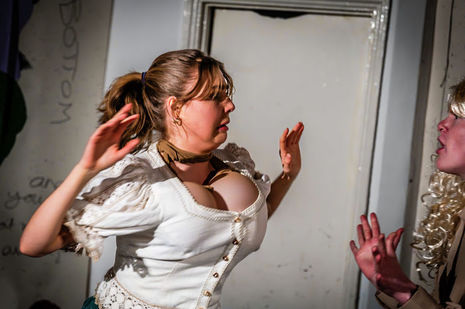An insider look into the world of costume design
Jasmine Wong goes behind the scenes with Abi Beton to explore the creation of the ADC’s iconic costumes

Costume designing is often overlooked; we rarely pay attention to the pivotal role it plays in films, our favourite television shows, or even the plays you might have watched at the ADC Theatre. Yet after discussing the importance of correct costuming with a student costumier, the integral role it plays in building a character can’t be overstated.
Meet Abi Beton, a first-year AMES student with an undeniable talent for costume design. Abi reflects on the general reception to costume design, “I would say that costumes are the sort of thing that if you get wrong, people notice. If you get it right, people just go, wow, it looks good.”

How does one even get into costume design? As with many other niche hobbies, the answer is unsurprisingly lockdown — Abi first got started in costume design during the pandemic. With all the extra free time, she turned to cosplay and recreating costumes as a creative outlet.
““I think it’s nice not to feel those boundaries there” between the imaginary and practical everyday fashion”
Naturally, as a Cambridge student, she tells me that, “one of my costume philosophies is that I can’t be bothered doing anything easy.” She tells me that her imagining of Six The Musical’s Anne Boleyn costume is one of her proudest recreations, “I wanted to go for the Six costumes because the fabrics are so hard, I never thought I’d be able to make it.” It was challenging working with a fabric she’d never worked with before. The plastic material didn’t allow much room for mistakes, and glueing each and every rhinestone onto a pair of black boots from Vinted was a painstaking task. But the toil paid off in the end, with her Anne Boleyn costume getting featured on Six The Musical’s official Instagram.

Being a costumier has influenced Abi’s everyday fashion too, as she explains that “I think it’s nice not to feel those boundaries there” between the imaginary and practical everyday fashion. Sometimes she even incorporates accessories or parts of her costumes in her everyday dress, like her billowy white button-up blouse that was once part of a pirate costume. When asked what her main consideration is when designing, Abi says, “what I try and think about is, has the character dressed themselves?” She then provided some examples of what she considers: “What they can afford in terms of fabrics, whether they’re the sort of person who likes showing off a lot of skin, or what they prioritise when dressing.”
“Looking at costume design prompts us to look even deeper, to understand that we dress the way we do for a reason”
Fashion is often written off as superficial, but we very much (subconsciously or not) consider the same things that Abi thinks about when designing her characters’ costumes when making our everyday outfit choices. “I think it’s really interesting how you pick your clothes based on who you want to be associated with and how you want to be seen. If you want to be perceived in a certain way, you wear the clothes that kind of reflect that.” Looking at costume design prompts us to look even deeper and to understand that we dress the way we do for a reason — even if our everyday outfit is a seemingly mundane pair of jeans and a sweater.
Abi eventually hopes to make costume designing her career and has costumed plays in Cambridge, like The Complete Works of Shakespeare (Abridged) - an absurd sketch comedy that was performed in Michaelmas. Abi knew her director, Rosie, had wanted to go for a “Jacobean aesthetic”, but found her main challenge to be fitting the costume design “within the vibe of a Shakespearean show” while balancing the scripts’ and actors’ inherent modernity. So to have something that “really made it pop and distinct”, she went with a combination that might not occur to most of us; Neon-coloured socks, converse sneakers, and a top with a Jacobean silhouette.

Costume design, by nature, also requires the costumier to consider the gendered line that fashion has historically sought to define, push, and blur. She was aiming for the characters to “all (have) sort of an androgynous look, because throughout the show they all played different genders.” The androgynous and ambiguous look Abi achieved meant that Blossom Durr, the actress pictured above, was easily able to portray both the Nurse (while wearing a pair of fake boobs) and Othello.
However, it’s not easy being a costumier in student productions. While ideas may be endless, the funds most definitely are not. This particular play had a tight £100 budget. A large part of being a costumier turns out to be sourcing materials within monetary constraints, “the tights were easy enough to get, but everything else was hard to find.” Abi recalls “working with the ADC costume cupboard,” where “they don’t have that many costumes for each historical period.” Also, because most plays tend to only have one person in charge of costuming, it can get quite solitary, “I think actually making costumes can be a bit lonely, because you sort of sit in your room and work on it yourself.”
Currently, Abi is excitedly working with another costumier for the designs in a new play Emma, which you’ll be able to catch in week 7 of this Lent term at the ADC. Whilst I can’t reveal the exclusive insider information concerning the costuming concept for Emma, rest assured you will be amazed.
 Comment / Plastic pubs: the problem with Cambridge alehouses 5 January 2026
Comment / Plastic pubs: the problem with Cambridge alehouses 5 January 2026 News / New movement ‘Cambridge is Chopped’ launched to fight against hate crime7 January 2026
News / New movement ‘Cambridge is Chopped’ launched to fight against hate crime7 January 2026 News / Uni-linked firms rank among Cambridgeshire’s largest7 January 2026
News / Uni-linked firms rank among Cambridgeshire’s largest7 January 2026 News / SU stops offering student discounts8 January 2026
News / SU stops offering student discounts8 January 2026 News / Cambridge businesses concerned infrastructure delays will hurt growth5 January 2026
News / Cambridge businesses concerned infrastructure delays will hurt growth5 January 2026









